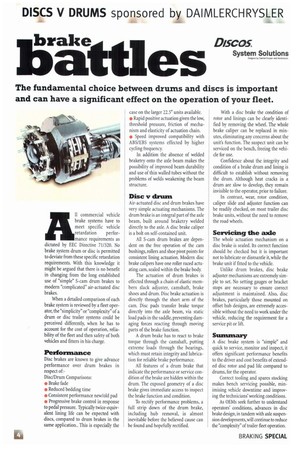leigittles
Page 118

If you've noticed an error in this article please click here to report it so we can fix it.
The fundamental choice between drums and discs is important and can have a significant effect on the operation of your fleet.
All commercial vehicle brake systems have to meet specific vehicle retardation performance requirements as dictated by EEC Directive 71/320. No brake system drum or disc is permitted to deviate from these specific retardation requirements. With this knowledge it might be argued that there is no benefit in changing from the long established use of "simple" S-cam drum brakes to modern "complicated" air-actuated disc brakes.
When a detailed comparison of each brake system is reviewed by a fleet operator, the "simplicity" or "complexity" of a drum or disc trailer systems could be perceived differently, when he has to account for the cost of operation, reliability of the fleet and then safety of both vehicles and fitters in his charge.
Performance
Disc brakes are known to give advance performance over drum brakes in respect of: Disc/Drum Comparisons: • Brake fade • Reduced bedding time • Consistent performance new/old pad • Progressive brake control in response to pedal pressure. Typically twice-equivalent lining life can be expected with discs, compared to drum brakes in the same application.. This is especially the case on the larger 22.5" units available.
• Rapid positive actuation given the low, threshold pressure, friction of mechanism and elasticity of actuation chain.
• Speed improved compatibility with ABS/EBS systems effected by higher cycling frequency.
In addition the absence of welded braketry onto the axle beam makes the possibility of improved beam durability and use of thin walled tubes without the problems of welds weakening the beam structure.
Disc v drum
Air-actuated disc and drum brakes have very simple actuating mechanisms. The drum brake is an integral part of the axle beam, built around braketry welded directly to the axle. A disc brake caliper is a bolt on self-contained unit.
All S-cam drum brakes are dependent on the free operation of the cam bushings, rollers and shoe pivot points for consistent lining actuation. Modern disc brake calipers have one roller raced actuating cam, sealed within the brake body.
The actuation of drum brakes is effected through a chain of elastic members slack adjuster, camshaft, brake shoes and drum. Disc brake actuation is directly through the short arm of the cam. Disc pads transfer brake torque directly into the axle beam, via static load pads in the saddle, preventing damaging forces reacting through moving parts of the brake function.
A drum brake has to react to brake torque through the camshaft, putting extreme loads through the bearings, which must retain integrity and lubrication for reliable brake performance.
All features of a drum brake that indicate the performance or service condition of the brake are hidden within the drum. The exposed geometry of a disc brake gives immediate access to inspect the brake function and condition.
To rectify performance problems, a full strip down of the drum brake, including hub removal, is almost inevitable before the believed cause can be found and hopefully rectified. With a disc brake the condition of rotor and linings can be clearly identified by removing the wheel. The whole brake caliper can be replaced in minutes, eliminating any concerns about the unit's function. The suspect unit can be serviced on the bench, freeing the vehide for use.
Confidence about the integrity and condition of a brake drum and lining is difficult to establish without removing the drum. Although heat cracks in a drum are slow to develop, they remain invisible to the operator, prior to failure.
In contrast, wear, rotor condition, caliper slide and adjuster function can be readily checked, on most trailer disc brake units, without the need to remove the road wheels.
Servicing the axle
The whole actuation mechanism on a disc brake is sealed. Its correct function should be checked but it is important not to lubricate or dismantle it, while the brake unit if fitted to the vehicle.
Unlike drum brakes, disc brake adjuster mechanisms are extremely simple to set. No setting gauges or bracket stops are necessary to ensure correct adjustment is maintained. Also, disc brakes, particularly those mounted on offset hub designs, are extremely accessible without the need to work under the vehicle, reducing the requirement for a service pit or lift.
Summary
A disc brake system is "simple" and quick to service, monitor and inspect, it offers significant performance benefits to the driver and cost benefits of extended disc rotor and pad life compared to drums, for the operator.
Correct tooling and spares stocking makes bench servicing possible, minimising vehicle downtime and improving the technicians' working conditions.
As OEMs seek further to understand operators' conditions, advances in disc brake design, in tandem with axle suspension developments, will continue to reduce the "complexity" of trailer fleet operation.








































































































































